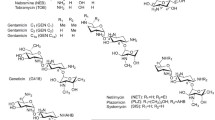Abstract.
Aminoglycoside antibiotics kill bacteria by binding to the ribosomal decoding site and reducing fidelity of protein synthesis. Since the discovery of these natural products over 50 years ago, aminoglycosides have provided a mainstay of antibacterial therapy of serious Gram-negative infections. In recent years, aminoglycosides have become important tools to study molecular recognition of ribonucleic acid (RNA). In an ingenious exploitation of the aminoglycosides’ mechanism of action, it has been speculated that drug-induced readthrough of premature stop codons in mutated messenger RNAs might be used to treat patients suffering from certain heritable genetic disorders.
Similar content being viewed by others
Author information
Authors and Affiliations
Corresponding author
Additional information
Received 23 January 2007; received after revision 25 February 2007; accepted 29 March 2007
Rights and permissions
About this article
Cite this article
Hermann, T. Aminoglycoside antibiotics: old drugs and new therapeutic approaches. Cell. Mol. Life Sci. 64, 1841–1852 (2007). https://doi.org/10.1007/s00018-007-7034-x
Published:
Issue Date:
DOI: https://doi.org/10.1007/s00018-007-7034-x




